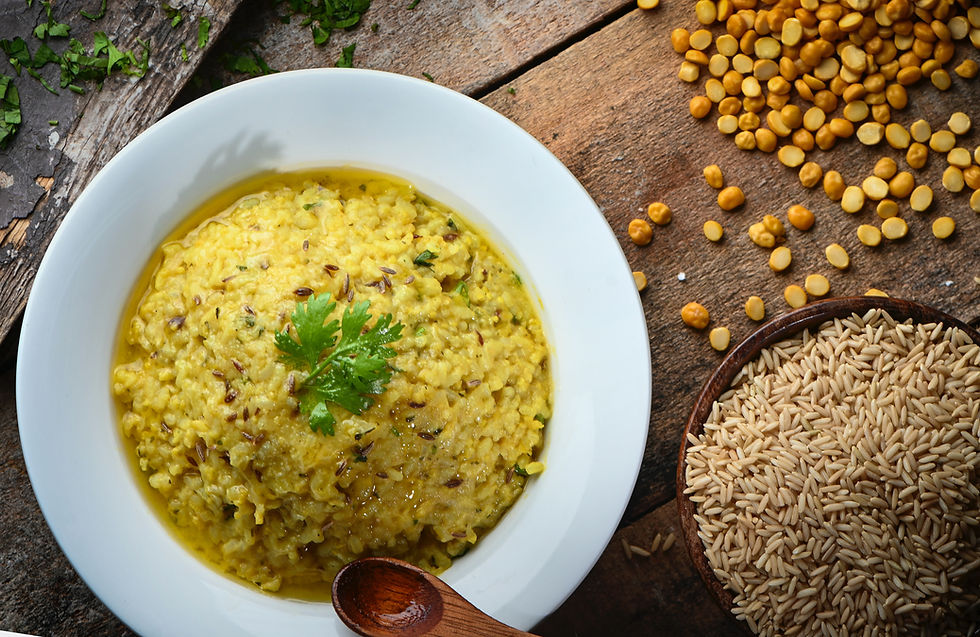Why Ayurvedic Cleansing Isn’t Just Another Detox: Kitchari vs. Juicing & Fasting
- Emma Herbert
- Aug 2
- 4 min read
In a world full of quick fixes and trendy detoxes, it’s easy to assume that all cleanses are the same. Skip meals, drink juices, feel lighter… right?
Not quite.
If you’ve ever tried a juice fast or a restrictive cleanse and ended up feeling dizzy, moody, or completely burnt out — you’re not alone. From an Ayurvedic perspective, there’s a good reason why that happens.
Let’s explore the difference between an Ayurvedic mono-diet cleanse (like eating kitchari) and more modern fasting trends — and why choosing the right kind of cleanse for your body can make all the difference.

What Is an Ayurvedic Cleanse?
An Ayurvedic cleanse is a gentle, nourishing way to reset the body by supporting digestion (Agni), removing built-up toxins (Ama), and restoring balance to the doshas (Vata, Pitta, and Kapha).
Rather than depriving the body, it uses warm, easy-to-digest food — traditionally kitchari — to allow the digestive system to rest and repair.
What Is Kitchari?
Kitchari is a simple, one-pot dish made of mung dal, basmati rice, digestive spices, and sometimes vegetables. It’s the Ayurvedic equivalent of “chicken soup for the soul” — deeply nourishing, grounding, and balancing to all three doshas when prepared properly.
Because it’s easy to digest, your body can direct energy away from processing complex meals and towards cleansing and healing.
How Does This Compare to Juicing or Fasting?
Juice fasts typically involve drinking only fruit or vegetable juices for several days. While they may offer a quick hit of vitamins and feel light at first, they are often cold, raw, and high in sugar — which can:
Aggravate Vata (cold, dry, irregular)
Spike and crash Pitta (heat, sharpness)
Overwhelm Kapha if the juices are too sweet or cold
In Ayurveda, digestion thrives on warmth, regularity, and simplicity. Cold, raw juices are considered harder to digest, especially for those with weaker Agni or imbalanced Vata or Kapha.

Water or Dry Fasting
More extreme fasts that involve little or no intake (dry fasting, extreme intermittent fasting, etc.) may offer some benefits, but they can easily:
Increase Vata, leading to anxiety, insomnia, dryness, bloating, or scattered energy
Overheat Pitta, resulting in irritation, anger, or hyperacidity
Leave Kapha lethargic or emotionally ungrounded if the body isn't prepared properly
Have a negative effect on our agni (digestive fire)
Ayurveda teaches that sudden or aggressive cleansing can weaken the very systems we’re trying to support.
Why Kitchari can be a Better Choice
Kitchari is the gold standard of Ayurvedic cleansing because it strikes the perfect balance:
Warm, cooked, and spiced — ideal for stabilising Vata
Simple and unprocessed — helps calm Pitta
Light yet satisfying — prevents Kapha stagnation
Instead of stripping the body or shocking the system, a mono-diet cleanse gently rekindles your digestive fire, mobilises toxins, and supports natural elimination.
It also keeps blood sugar stable, avoids depletion, and helps reduce cravings — all while giving your body a much-needed break from decision fatigue and overstimulation.

The Three Phases of an Ayurvedic Cleanse (That Are Usually Missed in the West)
Unlike many modern detoxes, an Ayurvedic cleanse follows a structured, three-phase process:
Preparation (Purva Karma)
This phase is all about gently preparing the body for deeper cleansing. You begin by removing heavy, processed foods, caffeine, and stimulants. Meals become simpler, digestion is supported with warming teas and herbs, and daily routines like tongue scraping and oil massage (abhyanga) are introduced. Without proper preparation, jumping straight into a cleanse can shock the system and aggravate the doshas — especially Vata.
Active Cleansing (Pradhana Karma)
This is the core phase of the cleanse, where you follow a mono-diet of kitchari (or another appropriate variation), allowing the digestive system to rest and toxins (Ama) to be mobilised. Gentle movement, rest, and self-care practices support elimination. Instead of starving or depleting the body (as in fasting or juicing), this phase works with your body to support natural detoxification and repair.
Rejuvenation (Paschat Karma)
Possibly the most overlooked — and most important — phase. Here, you slowly reintroduce more variety into your diet and lifestyle, focus on rebuilding digestive strength (Agni), and nourish the tissues with restorative herbs, foods, and practices. Cleansing creates space. Rejuvenation fills that space with vitality. Skipping this phase can lead to fatigue, depletion, or the return of old habits. It’s a reset for the body and the mind.

The Deeper Layer: Ayurveda Is About Rhythm, Not Restriction
Modern cleanses often follow a push-hard, then crash cycle — driven by willpower or punishment. Ayurveda sees cleansing differently.
It’s not about doing more or being better — it’s about restoring your natural rhythm.
In Ayurveda, we cleanse seasonally, not randomly. We simplify meals, we slow down, we care for the nervous system, and we honour the body’s unique needs. A kitchari cleanse includes rest, self-care rituals like oil massage, gentle movement, herbal teas, and time in nature.
Final Thoughts
If you’ve felt depleted or imbalanced after a juice fast or a strict detox, it might not be because cleansing “isn’t for you” — it might just mean your body needs a different kind of cleanse.
An Ayurvedic kitchari cleanse supports the body from the inside out — without stress, restriction, or crash cycles. It’s gentle, sustainable, and deeply balancing for the doshas.
Because true cleansing isn’t about deprivation — it’s about nourishment.
Ready to reset with Ayurveda?
Explore my upcoming seasonal cleanse, where you’ll be guided step-by-step through a nourishing 10-day kitchari reset — complete with daily routines, breathwork, and support to bring your body and mind back into balance.
Let’s return to your natural rhythm — together.




Comments